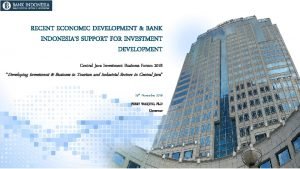MacroPrudential Supervision Lessons learned from the crisis Hilda












- Slides: 12

Macro-Prudential Supervision Lessons learned from the crisis Hilda Shijaku Financial Stability Department

Albanian Banking System n Banks operating in the market: n n 14 banks 2 branches of foreign banks n Activity: universal banking. n Major operations: n n n Deposits Loans Placements Treasury Bills & Government bonds Other foreign securities

Albanian Banking System n Proprietorship: Foreign capital Domestic capital – strongly prevailing – slightly taking over

Albanian Banking System

Albanian Banking System Presence of foreign banks: n Helped building of the entire system n Know-how brought in the country n Widely spread banking services (geographically) n New products offered n Supported the economic growth

Basel II § Not fully implemented § Pillar I – not implemented § § Pillar II – partially implemented. § § n Presently working on the implementation of Standardized Approach No regulatory framework in place. Actions taken in conform to the supervisory principles Pillar III – Partially implemented n There is a regulatory framework in place for publication of information

Lessons learned from the crisis § Crisis imported § § § Impact on banking system § § § First impact – confidence of the public Second impact – real economy Deposit withdrawal Liquidity drainage Decreased lending Increased NPL Impact on economy

Effects on banks balance sheets n n Initial state Dep withdrawal n n n How much dependent on mother banks? ? Stress tests Information and risk management systems not in place New regulation on liquidity management Credit growth n n Npl change in structure n n But only gradual Capital adequacy

FSI

The authorities response § Formal Measures taken § § § § Liquidity provided to banks through the use of reserve requirement (from 20% to 40%) Limited exposure to banks’ related parties (from 20% to 10 %) SC decision to stop dividend distribution of the 2008 and 2009 profit Decrease of the monetary policy rate ( 1% in January and October) Change in the auction form (Bo. A providing liquidity at a fixed rate) Increased deposit insurance coverage Requirements § § § Improvement of risk management practices Decisions based on prior analysis and stress-testing Maintain good level of capital adequacy at any time Continue lending policy to avoid pro-cyclical effects Smooth the impact on exchange rate regime

Lessons learned from the crisis § Evidenced weaknesses credit requirements in good times § Loose § risk management practices, structures & policy partially implemented § High exposure to foreign currency lending § Poor attention to macro developments

Lessons learned from the crisis § Strength § High liquidity § Good capitalization § Low exposure to foreign markets § Good support from mother banks
 Macroprudential policies
Macroprudential policies Macroprudential policy
Macroprudential policy Macroprudential intermediation ratio
Macroprudential intermediation ratio Workday claremont colleges
Workday claremont colleges 2 chronicles 34:1-3
2 chronicles 34:1-3 Lessons learned suomeksi
Lessons learned suomeksi Lessons learned faa
Lessons learned faa Lessons not learned in blood
Lessons not learned in blood Strawman report
Strawman report Life of pi moral lesson
Life of pi moral lesson The contest at mount carmel summary
The contest at mount carmel summary Pmbok lessons learned
Pmbok lessons learned Lesson learned in typhoon yolanda
Lesson learned in typhoon yolanda






















